Key takeaways
- Exorcism rituals serve as a reflection of humanity’s struggle with internal and external challenges, blending faith, psychology, and cultural traditions.
- Different cultures approach exorcism in unique ways, from Christian prayers to African music and Japanese offerings, highlighting diverse methods of confronting the unknown.
- Modern interpretations of exorcism often focus on healing and psychological well-being, fostering a connection between faith and mental health.
- Lessons from exorcism can be applied to contemporary issues, emphasizing the importance of rituals in reclaiming agency and promoting resilience during personal crises.
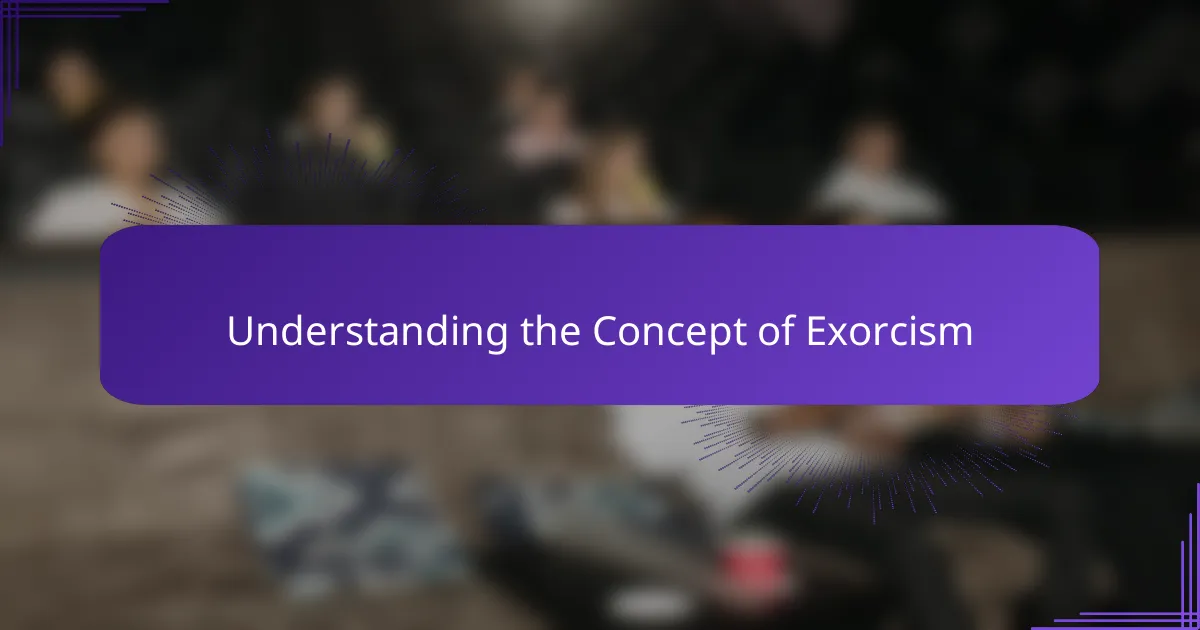
Understanding the Concept of Exorcism
When I first encountered the concept of exorcism, I was struck by how deeply it taps into our fundamental fears and hopes—fear of the unknown and hope for liberation. Exorcism, at its core, is about expelling an unwanted spiritual presence believed to cause harm or distress. But have you ever wondered why such rituals persist across so many cultures and centuries?
What fascinates me most is how exorcism blends faith, psychology, and ancient tradition. When I reflect on stories of exorcisms, I see not just battles against evil spirits but also moments of profound human vulnerability and resilience. It makes me question: are these rituals solely about the supernatural, or do they serve a deeper psychological need to reclaim control in times of chaos?
Understanding exorcism means recognizing it as more than just a dramatic ritual—we’re looking at a symbolic act that reflects humanity’s ongoing struggle with inner and outer darkness. Personally, I’ve felt a mix of curiosity and respect for those who perform these rites, knowing they navigate realms beyond our everyday experience. Isn’t it intriguing how something so ancient still holds meaning today?
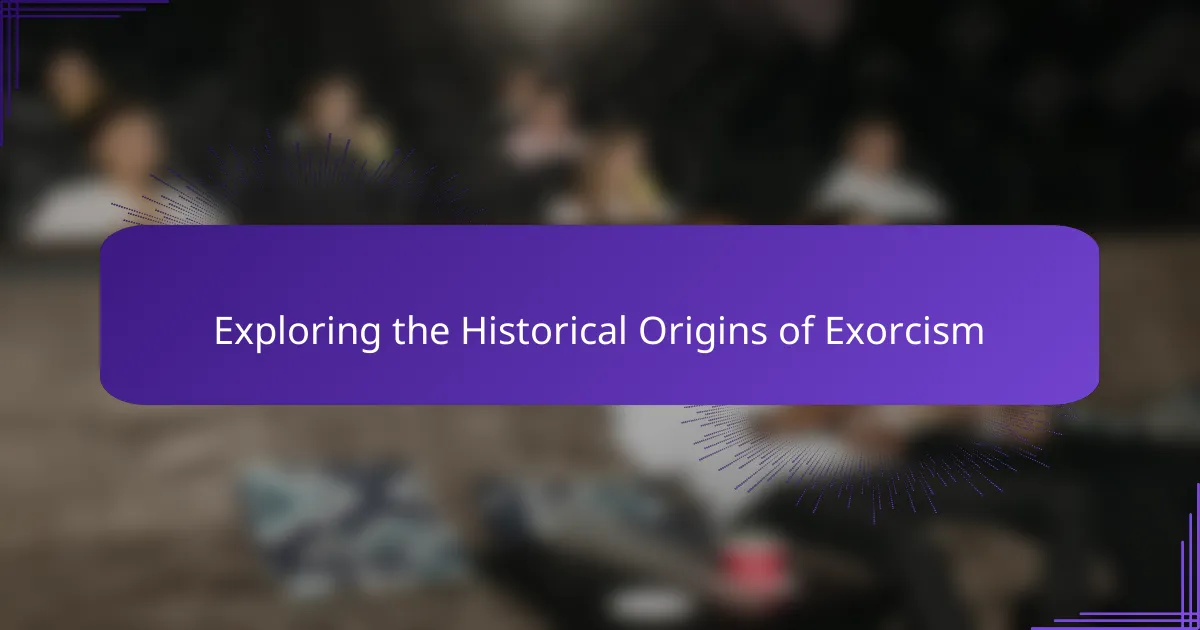
Exploring the Historical Origins of Exorcism
When I first dug into the historical origins of exorcism, I was amazed to find its roots stretching back thousands of years, crossing cultures and continents. Ancient civilizations like the Mesopotamians and Egyptians practiced rituals to drive out spirits, showing how deeply ingrained this need to confront unseen forces is in human history. Doesn’t it make you wonder how much of our modern fears and beliefs trace back to those early encounters with the unknown?
What really caught my attention was how exorcism evolved alongside religious traditions. From the solemn ceremonies in early Judaism to the detailed rites in [censured], these practices reveal a fascinating blend of [censured] and cultural values. I often think about the people who participated in those ancient rituals—did they feel the same mix of fear and hope that we still sense today when facing our personal demons?
It’s also striking how exorcism has always been about more than just scaring away spirits; it reflects our quest to understand and control the mysteries that surround us. My experience researching this made me realize that these rites serve as a mirror to human vulnerability and our endless search for meaning. Have you ever considered that exorcism is as much about confronting the darkness inside us as it is about casting out anything outside?
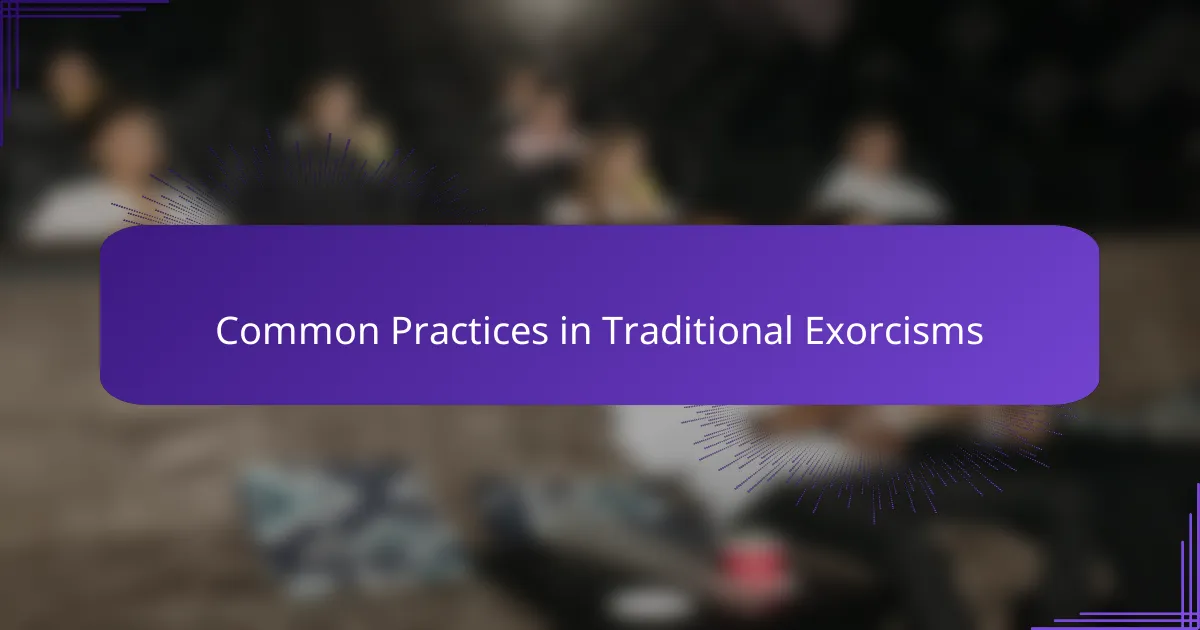
Common Practices in Traditional Exorcisms
One common practice that caught my attention is the use of sacred objects—like holy water, crosses, or specific prayers—to create a protective barrier. I remember reading about how these items aren’t just symbolic but believed to hold genuine spiritual power, which made me wonder: could our faith in these tools amplify their effectiveness?
Another element that often appears in traditional exorcisms is the ritualistic invocation, where the exorcist calls upon divine names or forces to command the spirit to leave. I find it interesting how this formal, almost theatrical language serves both to assert authority over the spirit and to reassure the participants themselves. Have you ever noticed how saying certain words can make you feel more in control, even in the scariest moments?
Finally, the physical aspect—sometimes the exorcist performs gestures like laying on of hands or making the sign of the cross—adds a tangible connection to the ritual. From personal experience, I think this physical interaction helps ground the process in reality, making the intangible struggle against evil feel more real and manageable. Doesn’t it strike you how these small actions carry such weight in moments of crisis?
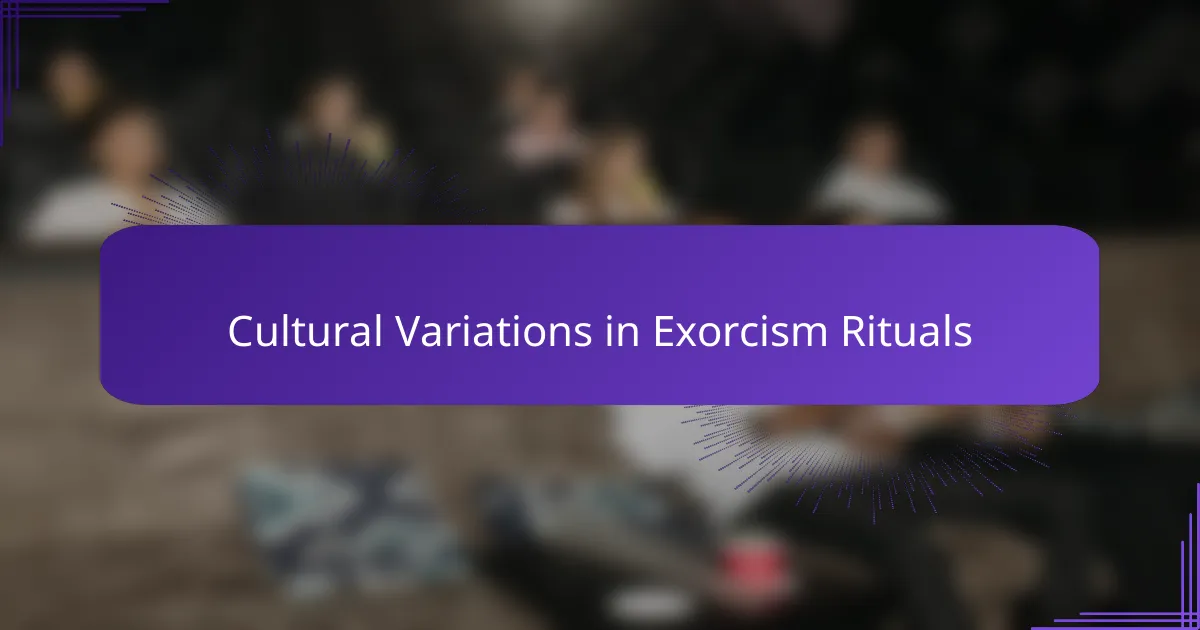
Cultural Variations in Exorcism Rituals
What really struck me in my research is how exorcism rituals differ so much depending on cultural context. For example, while Christian exorcisms often involve prayers and holy water, some African traditions use music and dance to chase away spirits. It makes me realize how each culture channels its unique worldview into the way it confronts the supernatural.
I’ve also noticed that in some Asian cultures, like in Japan, rituals include offerings and the use of talismans rather than direct confrontation. This approach feels less about domination and more about harmonizing with spiritual forces. Have you ever thought about how these different attitudes toward spirits reflect broader values within a society?
Another thing I find fascinating is how indigenous tribes in the Americas might incorporate community participation, turning exorcism into a collective event. In those moments, it’s not just about one person’s healing but about reinforcing social bonds and shared beliefs. From what I’ve seen, these variations remind me that exorcism is as much a cultural expression as it is a spiritual practice.
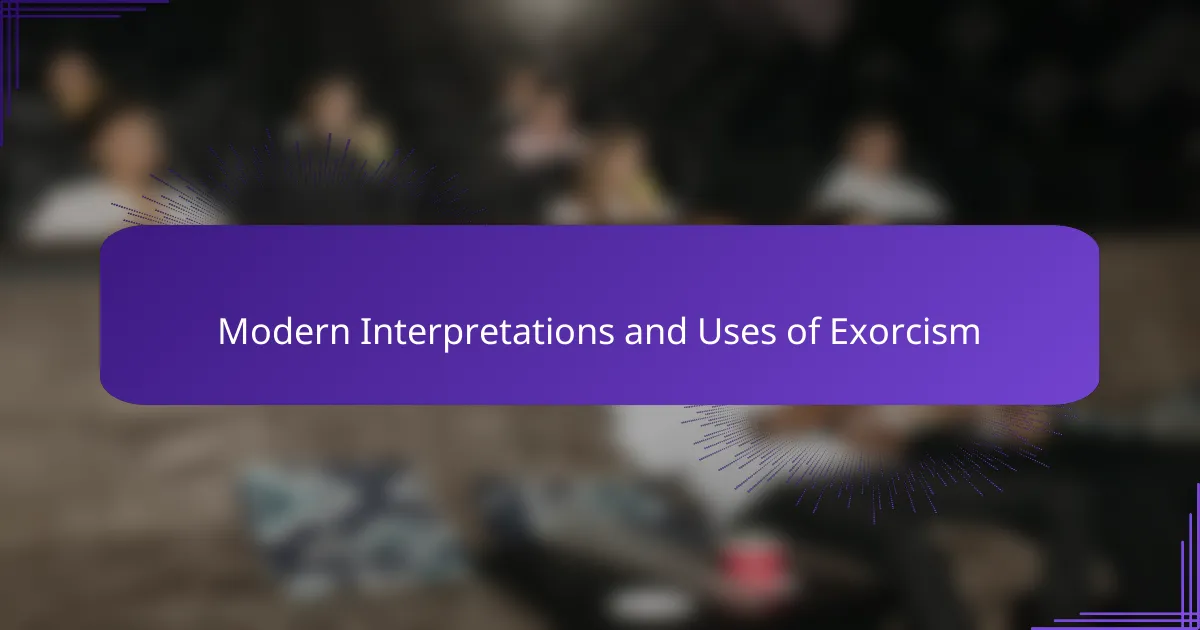
Modern Interpretations and Uses of Exorcism
I find modern interpretations of exorcism particularly intriguing because they often blend traditional beliefs with contemporary psychological understanding. It’s like the age-old ritual has evolved not only to confront supposed spirits but also to address mental and emotional struggles in a way that feels tangible to today’s society. Have you noticed how some practitioners now emphasize healing and restoration over mere banishment?
In my experience, exorcisms today sometimes serve as a bridge between faith and therapy, offering individuals a sense of control when facing unseen or internal battles. This dual role can make the ritual feel both mysterious and profoundly human. It makes me wonder if the ritual’s power lies less in what spirits it expels and more in what it reveals about the person undergoing it.
What’s more, I’ve seen exorcisms adapted beyond religious confines—sometimes incorporated into popular culture or paranormal shows—which changes their meaning yet keeps the core fascination alive. Don’t you think this modern twist speaks to our enduring need to explore the unknown, even if we approach it through the lens of entertainment rather than solemn ceremony?
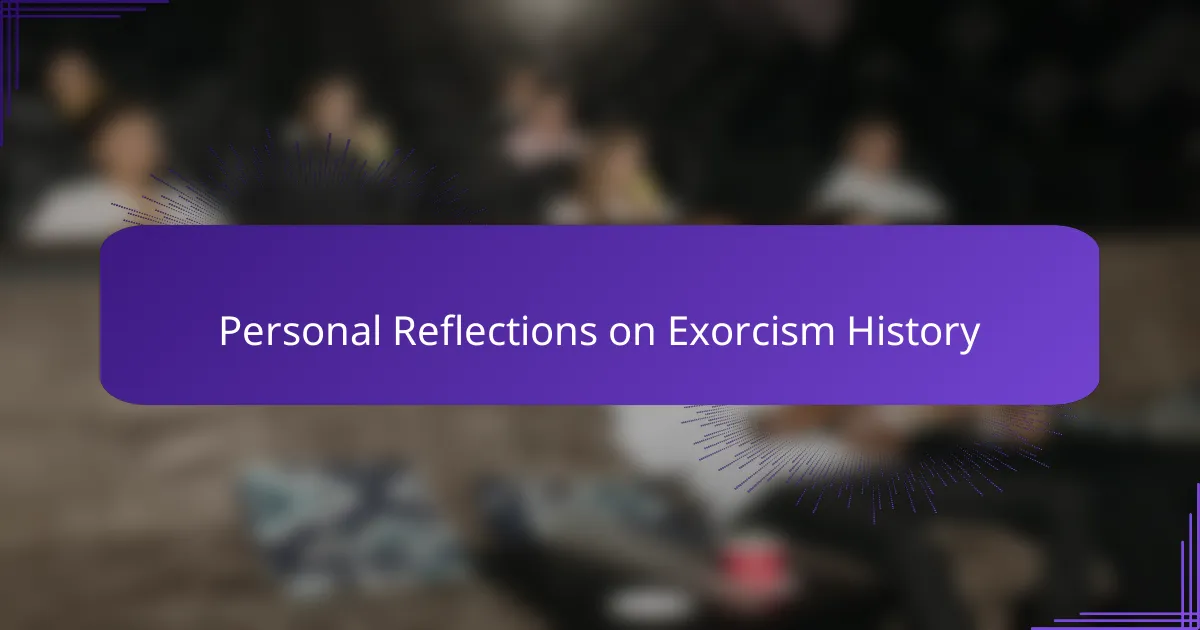
Personal Reflections on Exorcism History
Looking back on the history of exorcism, I can’t help but feel a sense of awe at how this practice has persisted through the ages. It strikes me that exorcism isn’t just a relic of ancient or religious traditions—it’s a living testament to humanity’s enduring struggle with fear, hope, and the desire for healing. Have you ever paused to consider how these rituals, born in vastly different times and places, still resonate on a deeply personal level today?
I remember reflecting on the stories of early exorcists and wondering what it must have been like to stand at the boundary between the known and the unknown. Their courage and conviction fascinate me; it’s as if they were pioneers navigating a mysterious world we’re still trying to understand. This historical perspective adds a layer of respect and curiosity in how I view contemporary encounters with exorcism.
At times, I think the historical journey of exorcism mirrors our own inner journeys—full of uncertainty but driven by a profound need to find balance and peace. Isn’t it remarkable how a practice so ancient continues to invite us to confront our shadows, both literal and metaphorical? For me, that’s what makes studying its history so personally compelling.
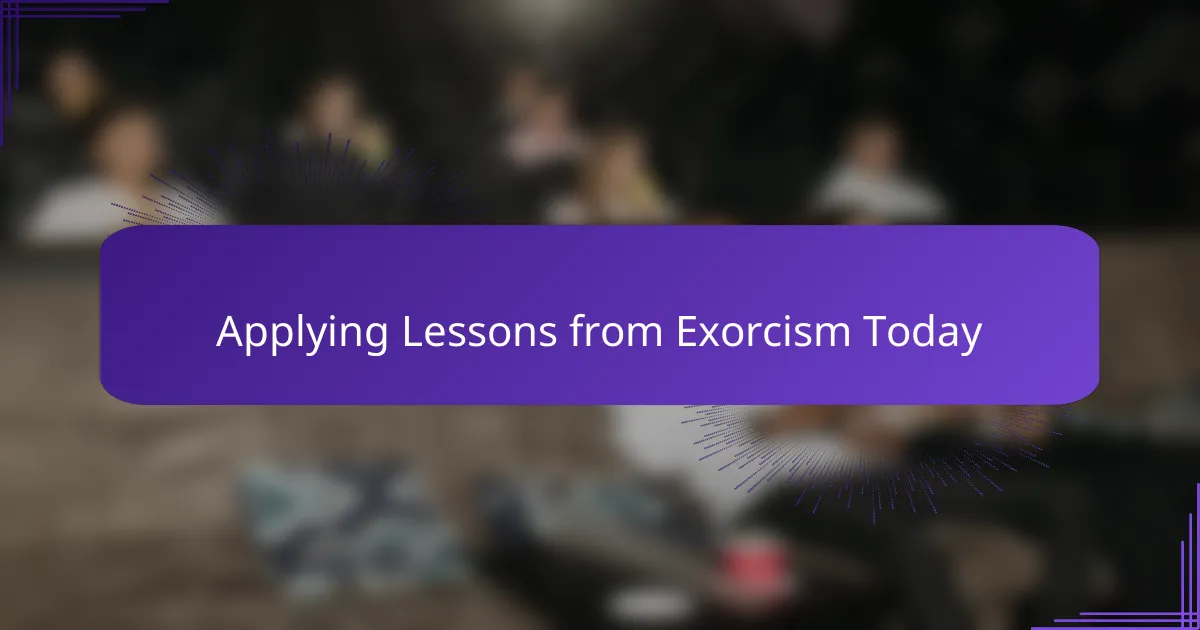
Applying Lessons from Exorcism Today
When I consider how lessons from exorcism apply today, I see a striking parallel with modern struggles for personal and communal healing. It’s not just about driving out spirits anymore; it’s about confronting the fears and doubts that haunt us internally. Have you ever noticed how facing one’s own “demons” can be just as challenging as any external challenge?
In my experience, the rituals and symbols of exorcism offer valuable tools for reclaiming agency during moments of deep distress. Whether it’s through prayer, meditation, or simply speaking words of affirmation, these acts create a framework for hope and resilience. Isn’t it powerful how a simple ritual can foster a sense of control when life feels overwhelming?
Finally, reflecting on exorcism’s history reminds me that many cultural practices still hold wisdom for today’s mental and spiritual health. I often think about how integrating ancient rituals with contemporary therapy could enrich healing processes. Could this fusion be the key to addressing the unseen battles people face in our modern world?